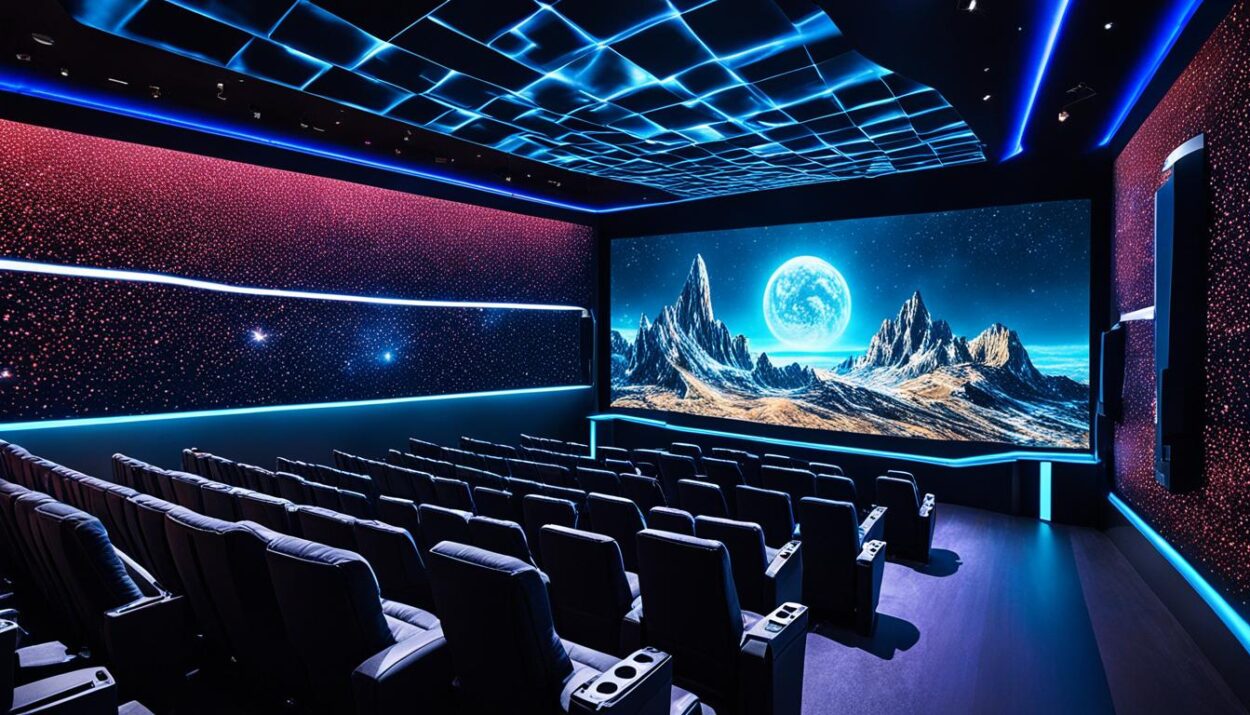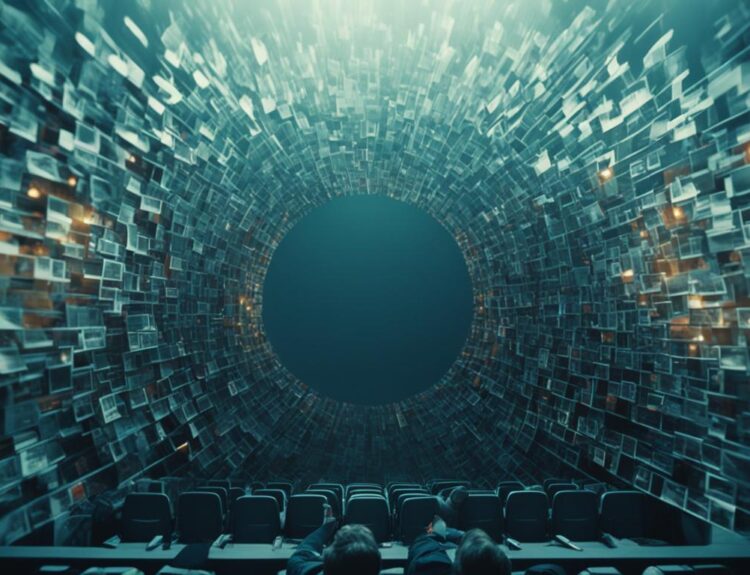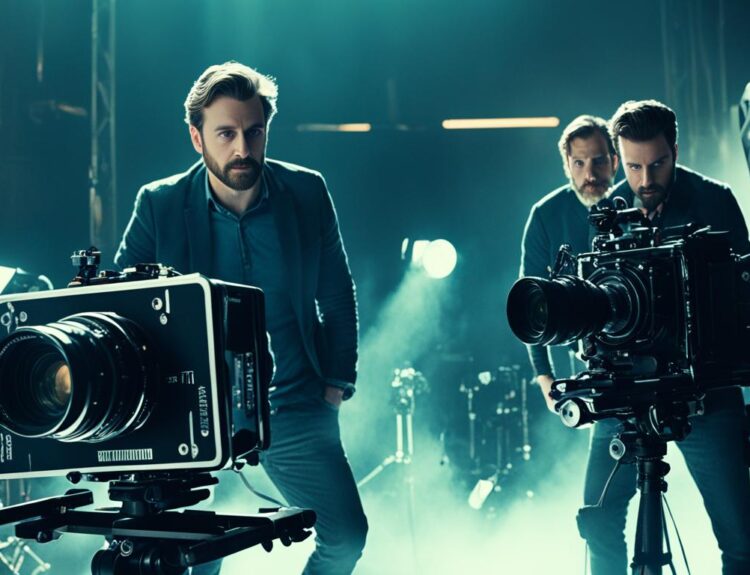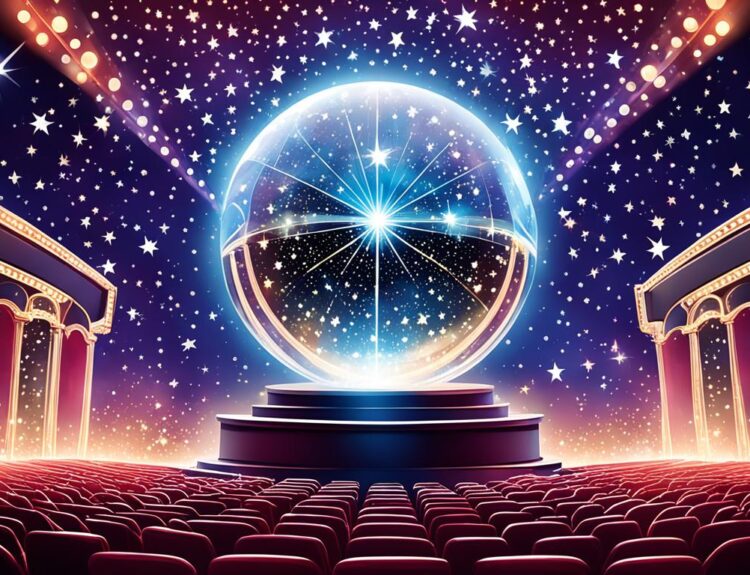The movie industry keeps growing, thanks to new trends and cool tech. Remember the nickelodeon theaters? Now compare them to the awesome cinematic experiences we have today. The change is huge! Movies like “Avatar” (2009) show us the power of computer graphics and motion capture1. These advances are leading us to exciting new changes in how movies are made, urging filmmakers to keep innovating and finding new ways to win over audiences.
Films have come a long way since “Gone With the Wind” (1939) and its $3.85 million budget. It was a big deal back then! Now, we’re entering an era of AI and VR, taking storytelling to the next level1. AI helps make editing faster by doing stuff like color correction and matching sounds automatically. Plus, tech is making realistic computer graphics cheaper to make2. As we move forward, it’s clear that these tech upgrades will make stories more engaging and fun for everyone, promising a bright future for films.
Key Takeaways
- The movie industry has undergone substantial evolution due to technological advancements.
- “Avatar” (2009) exemplifies the significant impact of modern CGI and motion capture.
- AI is enhancing post-production by automating tasks and reducing production costs.
- Innovative film technology like VR and AR are shaping future storytelling methods.
- Continuous innovation and adaptation are key to future audience engagement.
Introduction to Movie Industry Future Trends
The journey of the movie industry is full of big steps and key moments. “Gone With the Wind” in 1939 cost $3.85 million to make3. Jump to 2009, “Avatar” was produced with a whopping $237 million3. This shows how the industry has changed and grown over time.
Digital cinema has been a game-changer, introducing new film technologies. For example, virtual reality in movies creates immersive and interactive experiences4. Also, CGI has made it possible to bring to life real-looking characters and amazing new worlds4.
The impact of film tech is changing how movies are made, shared, and watched. Streaming services like Netflix and Amazon Prime are now big players4. Netflix had 238.39 million subscribers by July 31, 2023, showing how much people love streaming3. Also, better sound tech and HD audio make watching movies an even richer experience4.
The future of movies looks exciting with AI and VR changing how films are made. AI helps with scripts and effects, while VR makes movie-watching more immersive4. We’re headed for a new era of movies with cooler stories and more ways to feel part of them.
The Role of AI in Filmmaking
Artificial Intelligence (AI) is changing the movie-making world in big ways. It’s making scriptwriting and the work done after filming better and faster. AI helps from the start to the end of making a movie, sparking a wave of new creative ideas and work methods. Let’s look at how AI is making scriptwriting and post-production better.
AI in Scriptwriting
AI has pushed scriptwriting to exciting new levels. It can check lots of scripts quickly, making prep work faster5. Imagine how 20th Century Fox used AI to dig into the “Logan” script. This helped them make smart choices about the story and themes6. Also, by looking at successful scripts, AI can suggest ways to write stories that audiences will love7.
AI in Editing and Post-Production
AI shines in making post-filming work more efficient. Smart camera systems mean filming is precise and less expensive, boosting the filming process5. For example, Skywalker Sound used AI to sort and find sounds quickly, making their work faster6. Editing is smoother thanks to AI, with automatic and predictive editing making the final cut better7. Plus, AI helped make actors look younger in “The Irishman” without costly CGI6.
AI also helps film crews by predicting the weather and managing crowds better5. In marketing, AI was key to the “Aquaman” movie’s successful ad campaign6. Clearly, AI is becoming essential in making movies more engaging and telling better stories5.
Virtual Production Techniques
Virtual production is changing the way movies are made by blending real and digital scenes. This approach has evolved a lot in the past 50 years. Early methods started in the 1930s with rear projection, and front projection was used in the famous movie “2001: A Space Odyssey” (1968)8. Movies like “Avatar” (2009) took these techniques further, using motion capture and creating digital worlds8.
Now, shows like “The Mandalorian” are using high-tech stages with LED screens. This allows for real-time creation of rich and believable settings8.
The Rise of Virtual Reality (VR)
Virtual reality (VR) is taking cinema to new heights. It draws viewers deeper into the movie world with real-time views9. “Avatar” showed how VR can create vivid, three-dimensional places8. VR not only boosts creativity but also cuts costs by reducing the need for real sets8. It’s projected that the virtual production market will soar from USD 2.98 billion in 2023 to USD 9.62 billion by 2032. This jump is mainly due to VR becoming more common10.
Augmented Reality (AR) in Filmmaking
Augmented reality (AR) is adding a fresh layer to film by mixing digital elements with the real world. This mix makes for complex and unique movie experiences. AR’s quick rendering lets filmmakers make instant choices on set, reducing the need for heavy editing later10.
“The Lion King” (2019) is an example of how virtual production can merge computer-generated settings with live-action seamlessly8. A big trend is the use of AR and motion tracking. This ensures the digital and real scenes work together, improving the film’s quality9.
These tech advances are not just for movies. Gaming, advertising, and virtual events are also embracing virtual production. This shows how VR and AR are reshaping content creation across different fields10.
Streaming Platforms and Their Impact
Streaming services like Netflix have changed how we watch movies. In 2018, only 15% of folks chose to stream movies. By June 2020, that number jumped to 36%11. The popularity of movie theaters dropped. They faced big losses, with AMC losing $4.5 billion in 2020 due to the pandemic1112.
The Shift from Theatrical Releases to Streaming
More people now stream movies than go to theaters. By 2020, only 14% still preferred theaters, while 36% enjoyed streaming11. Netflix and similar services now have 220 million members worldwide12. Streaming is more affordable than theater tickets, making it a popular choice11.
Future of Cinema in the Streaming Era
The rise of streaming sparks debate over cinema’s future. Netflix plans to have all original content by May 202711. More Americans use streaming now than before, with 78% using these services by late 202112. To compete, traditional theaters must get creative and adapt to changes.
Immersive Experiences in Movies
Immersive cinema is changing how we tell and experience stories. Thanks to VR and AR, filmmakers can make movies that you can feel and explore. By 2024, these tools will be big in the movie world, offering stories like never before13. They turn viewers into active parts of the story, bringing them closer to the action.
VR and AR will change how we watch movies by making it more interactive. They also let stories change based on what the viewer likes. This way, movies can keep you hooked by adjusting to your interests13. Filmmakers get to build stories that respond and evolve, making watching more fun and personal.
Big companies are investing a lot in these new techs. For example, Disney spent $10.5 billion on new content in 202214. A lot of that money goes into VR and AR to make movies more engaging. Mixing movies with streaming services also helps to reach more people in enjoyable ways14.
The push for VR and AR in movies is a big deal. These technologies are changing how stories are told and experienced. They promise to bring new levels of immersion, making deep, interactive stories the norm in cinema.
Sustainability in Film Production
The film industry’s environmental impact is a big worry. More filmmakers are choosing sustainable ways to make movies. They’re using green filmmaking to cut down on their carbon footprint.
Green Filmmaking Practices
Big movies can create about 2,840 tons of CO2. That’s a lot and would need around 3,700 acres of forest to soak it up in a year15. Film studios are working hard to lower CO2 from transport. This is because transport makes up 51% of their total carbon emissions15.
They’re also using AI and virtual tech to reduce carbon on set16. Plus, data centers used in filmmaking add more than 2% to global carbon emissions15.
Case Studies of Sustainable Productions
Sustainable practices are becoming the norm. ‘The Amazing Spider-Man 2’ saved about $400,000 by being eco-friendly. It also cut down on 52% of its waste going to landfills15. BAFTA says making an hour of TV produces around 13 tonnes of CO216. This shows why trying to be carbon neutral is so important.
Studios are recycling, using less energy, and joining carbon offset programs to reach carbon neutrality15.
More focus on sustainability shows the film industry’s pledge to reduce environmental harm. With widespread green practices, cinema is moving towards a sustainable future.
| Aspect | Environmental Impact | Green Measures | Case Study Example |
|---|---|---|---|
| CO2 Emission | 2,840 tons per production15 | Transport emission reduction | ‘The Amazing Spider-Man 2’ – $400k saved15 |
| Waste Management | High waste from sets | Recycling props, 52% waste diversion15 | Disney’s carbon neutrality efforts |
| Virtual Production | Virtual sets reduce travel | Adoption of AI and previsualization16 | Netflix and Disney+ innovative practices |
Carbon neutrality efforts include green toolkits and certification to encourage sustainable practices15.
Diversity and Representation in Films
In recent years, people have been asking for films that show many different life stories. This change is making the movie industry look at who their movies are about. It has also made a big difference in what movies get made and who watches them.
Increased Demand for Diverse Voices
More movies and TV shows now have people of color in leading roles and behind the camera in 2023.17 A big change is seen as 29.2% of main characters come from diverse backgrounds. This is an increase of 8% from last year.18
Lily Gladstone made history as the first Native woman nominated for Best Actress at the Oscars. This shows how the industry is starting to appreciate talents from all backgrounds.18
Impact on Box Office and Audience Engagement
Movies that embrace different cultures are doing really well at the box office. Hits like “Creed 3,” “Scream 6,” and “John Wick: Chapter 4” were loved by many because of their diverse cast.17 In fact, movies with 31% to 40% diverse casts earned the most worldwide.17
On opening weekends, movies popular with people of color were among the top choices for 14 out of the 20 biggest films in 2023.18
However, it’s still hard for women to get top jobs in Hollywood. In 2023, for every female director, there were three male directors.1718 But movies like “Barbie,” directed by Greta Gerwig, show that women can also create big hits. It earned more than $1.4 billion globally.17
All these changes show diversity in movies is important. It makes stories more interesting and helps movies succeed both with audiences and in making money.
Interactive Storytelling in Movies
Interactive storytelling is transforming the movie industry. It allows audiences to take part in shaping the story. This means viewers get to influence the storyline, making the experience more engaging.
Technologies like Virtual Reality (VR) and Augmented Reality (AR) are behind this. They provide immersive experiences that are expected to become more popular in 202419. This push towards interactive storytelling invites unique and tailored narratives, keeping the film scene vibrant and inclusive19.
Narrative innovation is key in this new era of filmmaking. Filmmakers are adding interactive features that let people decide how the story goes. This creates a stronger bond between the story and its audience. With the help of artificial intelligence (AI) and machine learning, personalized movie experiences are becoming a reality19.
The easier access to filmmaking tools and platforms is also making a difference. It enables more storytellers to share their work, introducing fresh and diverse voices into the industry19. This change supports the growing interest in different narratives, showcasing a wide array of human experiences and promoting a more inclusive movie world19.
In conclusion, interactive storytelling marks a significant shift in how movies are made and enjoyed. With the help of VR, AR, and AI, the future of movies looks engaging and diverse. This change points to a bright future where viewers’ participation and creative storytelling lead the way.
Explore future filmmaking trends
Blockchain and NFTs in the Movie Industry
Blockchain technology and NFTs are transforming the movie sector. They change how we manage digital rights and film production. These innovations bring a new level of safety and transparency, making sure creators get their fair earnings.
How Blockchain Is Changing Rights Management
Blockchain makes digital rights management clear and secure. It keeps track of content use, helping filmmakers get paid right. Smart contracts on the blockchain can automatically send profits to everyone involved.
Dealing with royalties and earnings has often been murky and complex. Blockchain solves this by keeping a clear record of transactions. This transparency means creators get paid fairly and on time.
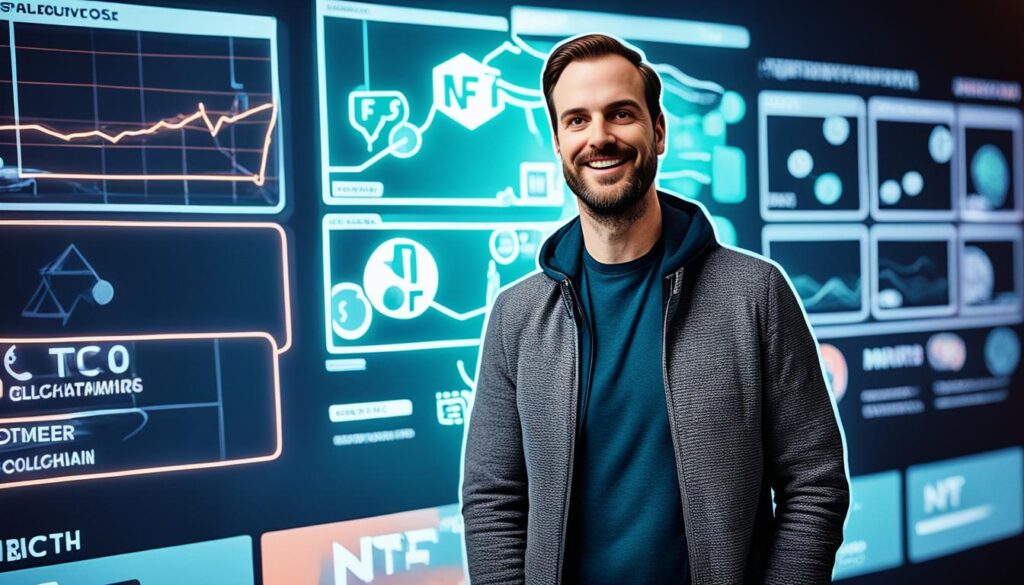
Future of NFTs in Film Production
Recently, NFTs have given filmmakers new ways to make money. For instance, Kings of Leon released NFTs in 2021, including unique album content and art. This not only brought in revenue but also offered perks like lifelong front-row concert seats20. NFTs also let creators earn from resales through smart contract royalties20.
In 2021, music artists earned $83 million from NFT sales. A huge 70% of this went to indie artists. This shows how NFTs boost individual creators20.
Trading sites like OpenSea and SuperRare make it easier for artists to sell digital and entertainment NFTs to a wide audience. This link discusses how NFTs are making big changes in entertainment. They open new doors for artists to earn money and connect with fans.
“Beeple sold his Days of Our Life NFT for $69 million in 2021. This set a record for digital art sales. It shows the huge value NFTs can create for digital content in movies.”20
NFTs offer more than just earnings for films. They also allow for funding through pre-selling unique digital items. Fans and backers can purchase NFTs, gaining exclusive access or limited-edition merchandise, and help fund movies.
Thanks to blockchain’s security and NFTs creating new earning ways, filmmaking’s future is bright. This mix of tech gives filmmakers new chances to safeguard, make money from, and share their work. This marks a big move towards a fairer and more streamlined movie industry.
Remote Collaboration Tools for Filmmakers
Nowadays, remote collaboration is key for filmmakers. This is true more than ever when productions are spread out. Cloud storage and AI document automation have made things more efficient. They make working together smoother and cut down risks21. These tools help teams work well together, even from afar. They keep projects moving smoothly by sharing updates and managing resources on the fly.
Unreal Engine 5.2 is changing the game in virtual production22. It lets filmmakers see and change scenes as they shoot. This is a big plus in decentralized production. Teams can create and modify virtual sets without needing to travel. Also, AI helps predict a film’s success by looking at trends and what viewers like22.
AI tools dig into what viewers prefer and find patterns in creativity. This helps filmmakers craft stories and dialogues that really speak to people22. Such tools can suggest fresh plot twists that keep viewers hooked22. Vitrina AI, for instance, makes film production teamwork smoother. It gives updates on market trends and how to work more efficiently23.
With the right tools, filmmakers don’t need as many meetings, which speeds up making movies and cuts down mistakes21. These tools also make it easy to work with people and clients all over the world21. This worldwide teaming up helps build strong, lasting partnerships. It drives success and growth in the movie world23.
The advent of remote collaboration and digital filmmaking tools is changing how movies are made. It makes the creative process better and opens doors to worldwide partnerships and decentralized ways of making movies.
Technological Advancements in Filmmaking Tools
Technological advancements are changing the filmmaking industry. New cameras and sound equipment expand film production possibilities. These innovations are redefining the standards of filmmaking.
Latest Innovations in Camera and Sound Technology
Advancements in camera technology innovation make stories more visually captivating. Today’s cameras have higher resolution and better image quality. They also have advanced autofocus and stabilization, making filming complex scenes easier.
Sound quality advancements enhance the viewer’s experience with clear audio. Modern microphones and audio technologies capture sound clearly. Together, these advancements in camera and sound tech produce high-definition films.
Post-Production Software Evolution
The evolution of post-production software has transformed editing. Modern editing tools are more powerful yet easier to use. They allow for intricate color grading, special effects, and sound editing, significantly speeding up the post-production process.
AI integration in post-production reduces manual work. Filmmakers can then focus on creativity while software manages technical tasks. These improvements are crucial for maintaining quality, time, and budget.
The cost of filmmaking has risen with technology. For example, “Gone With the Wind” cost $3.85 million in 1939. But, “Avatar” cost about $237 million in 20093. This shows the impact of tech on production costs.
- Enhanced camera technology innovation
- Cutting-edge sound quality advancements
- Efficient post-production software
Read more about the future of film technology trends.
Changes in Film Distribution Models
The way we get our movies is changing a lot. Now, there’s a mix of watching in theaters and online. This big change is making the movie industry think hard about how to get movies to people.
Hybrid Release Models
Now, movies come out in theaters and online at the same time. This helps movies reach more people. For example, in the US, the biggest movies in 2022 made up more of the box office24.
Big names like Netflix and Disney+ are leading this change. Disney+ got to 100 million subscribers, and Netflix has over 200 million worldwide14. These numbers show that releasing movies both ways works well.

Theatrical Distribution in the Web 3.0 Era
New tech is changing how we see movies in theaters too. In France, special formats like Dolby and IMAX are becoming more popular24. It shows people want cool new watching experiences.
Movies coming to theaters for a short time, and then online, is tricky but exciting. For example, AMC almost went under but got help from investors24. This new era could make watching movies even better.
The table below shows how much money big streaming services spent on new shows and movies. It really shows how big the changes in movie distribution are:
| Platform | Investment in 2022 |
|---|---|
| Netflix | $5.8 billion14 |
| Amazon | $7 billion14 |
| Disney+ | $10.5 billion14 |
Implications of AI and VR on Audience Engagement
AI and VR are changing the way we experience movies, making them more interactive and immersive. These technologies let stories reach viewers in new ways, making them feel more involved. Thanks to AI and VR, people will soon move from just watching stories to being a part of them.
The Future of Interactive and Immersive Movies
Interactive movies are now a big deal, thanks to AI. For example, Netflix uses data from over 200 million hours watched daily to recommend shows that fit what you like25. This shows how AI is making it easier for viewers to find content they’ll enjoy.
At CES 2023, there were cool demos like VR headsets and new gaming systems25. These let people dive into stories and play a role in them, offering a new level of fun and engagement.
In 2018, an AI-made portrait called “Edmond de Belamy” was sold for $432,500 at Christie’s25. This sale showed how AI could also impact the arts and entertainment. Future trends include better personalization in movies, using AI to understand what viewers want, and more AI in live shows25.
VR is also helping movie makers create better characters in interactive films25. These improvements make stories more exciting and let viewers change how the story goes. It’s like being in a game and a movie at the same time.
As AI and VR get better, they’re going to make movies way more engaging. Soon, we might all get to choose how stories unfold for us. This will totally change movies and how we get into them.
Future Predictions for the Movie Industry
The film industry is on the brink of big changes. This is because of new technology and what viewers now want. These changes will shape the future of movies and how we enjoy them.
What Will Movies Look Like in the Next Decade?
Soon, movies will use more virtual reality (VR) and augmented reality (AR). This will make movie-going an immersive experience like never before1419. Filmmakers are using VR to put viewers into the story, making movies more engaging19. Also, AI will make editing faster, improving visuals while cutting down on time and costs1419.
Movies will soon come out in theaters and online at the same time. This meets viewers’ needs and may bring in more fans14. Plus, with better home theater systems, people can have a movie theater experience right at home.
Potential Challenges and Opportunities
New tech like VR and AI can be expensive, especially for indie filmmakers. Yet, there’s a trend of making great films on tight budgets14. This suggests everyone will continue to have a chance to make movies.
Piracy is a big problem, affecting movie profits and subscriptions. The industry hopes blockchain can secure digital rights, ensuring creators get paid19. Emphasizing green practices also lessens the film industry’s environmental toll19.
Diversity in stories is key to drawing in and keeping viewers. Such storytelling meets cultural needs and can also be commercially successful. As movies evolve, blending tech advances with inclusivity and green practices is vital for lasting success.
| Trend | Impact | Stages |
|---|---|---|
| VR and AR Integration | Immersive Experiences | Early Adoption |
| AI in Post-Production | Enhanced Efficiency | Growing |
| Hybrid Release Models | Increased Viewership | Expanding |
| Sustainable Filmmaking | Reduced Environmental Impact | Emerging |
| Diverse Storytelling | Higher Engagement | Maturing |
Conclusion
Reflecting on the film industry’s journey, three key forces emerge as driving factors: innovation, sustainability, and inclusivity. The costs of producing movies have skyrocketed. From the $3.85 million spent on “Gone With the Wind” in 19393 to the $237 million for “Avatar” in 20093, the leap in technology and storytelling is clear. This trend shows the industry’s creative potential and adaptability.
Today, streaming platforms like Netflix have altered how we watch films. With 238.39 million subscribers by mid-20233 and Disney+ reaching 100 million14, the move from theaters to digital is evident. Amazon and Disney’s massive investments in content highlight the demand for new and varied stories.
Efforts towards sustainability are seen in Disney’s commitment to zero-waste practices3. Films today blend genres, include social themes, and tell stories in innovative ways. The rise of VR and AR tech promises an even more immersive future for cinema14.
In conclusion, the film industry’s future is bright, fueled by ongoing innovation and societal changes. It’s a collaborative effort among filmmakers, studios, and viewers. Together, they ensure cinema remains a vibrant reflection of our culture, thrilling us for years to come.
FAQ
What are the current future trends in the movie industry?
How is AI influencing the filmmaking process?
What role do VR and AR play in modern filmmaking?
How are streaming platforms affecting traditional cinema?
What are immersive experiences in movies, and how are they changing audience engagement?
How is the film industry addressing sustainability?
Why is diversity and representation important in films?
What is interactive storytelling in the context of movies?
How are blockchain and NFTs being used in the movie industry?
What tools are filmmakers using for remote collaboration?
What are the latest technological advancements in filmmaking tools?
How are changes in film distribution models affecting the industry?
What are the implications of AI and VR on audience engagement?
What are some future predictions for the movie industry?
Source Links
- https://filmustage.com/blog/unfolding-the-future-of-film-technology-key-trends-to-watch
- https://tmff.net/the-future-of-filmmaking-technologies-and-trends/
- https://filmustage.com/blog/unfolding-the-future-of-film-technology-key-trends-to-watch/
- https://www.quantzig.com/blog/4-media-trends-film-industry/
- https://medium.com/@channelasaservice/exploring-the-impact-of-ai-on-film-production-in-2024-f02da745af00
- https://www.forbes.com/sites/neilsahota/2024/03/08/the-ai-takeover-in-cinema-how-movie-studios-use-artificial-intelligence/
- https://stewarttownsend.com/the-future-of-filmmaking-ai-film-production-in-2024/
- https://amt-lab.org/blog/2023/7/ai-and-virtual-production-the-past-meets-the-future
- https://animost.com/ideas-inspirations/virtual-production/
- https://www.linkedin.com/pulse/untapped-potential-virtual-production-market-global-biz-news-xaghf?trk=organization_guest_main-feed-card_feed-article-content
- https://blog.filmtrack.com/industry-insights/streaming-platforms-and-their-impact-on-the-film-industry
- https://www.thedartmouth.com/article/2022/10/trends-streaming-services
- https://raindance.org/the-future-of-filmmaking-5-filmmaking-trends-to-watch-out-for-in-2024/
- https://www.sae.edu/gbr/insights/top-trends-in-modern-film-production-navigating-the-future-of-filmmaking/
- https://www.forbes.com/sites/sap/2022/02/28/how-film-production-is-becoming-more-sustainable-and-profitable/
- https://stageandcinema.com/2023/07/12/7-trends-reshape-the-future-film-industry/
- https://www.npr.org/2024/03/07/1236746667/ucla-hollywood-report-shows-audiences-want-diverse-films
- https://dailybruin.com/2024/03/26/2024-hollywood-diversity-report-shows-success-increase-in-racially-diverse-films
- http://raindance.org/the-future-of-filmmaking-5-filmmaking-trends-to-watch-out-for-in-2024/
- https://www.rollingstone.com/culture-council/articles/hollywood-meets-art-nfts-revolutionizing-entertainment-industry-1234736416/
- https://futuramo.com/blog/the-future-of-design-collaboration-tools-and-trends-shaping-creative-work/
- https://www.linkedin.com/pulse/future-film-industry-14-ways-artificial-intelligence-game-kanatt-wzcsc
- https://vitrina.ai/blog/film-production-collaboration-guide/
- https://tbco.medium.com/the-future-is-now-6-key-trends-that-will-transform-the-cinema-industry-in-2023-e9feec804e25
- https://www.ipcstore.com/blog/ai-is-changing-entertainment-industry-the-next-big-thing
